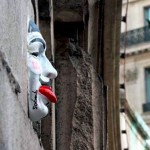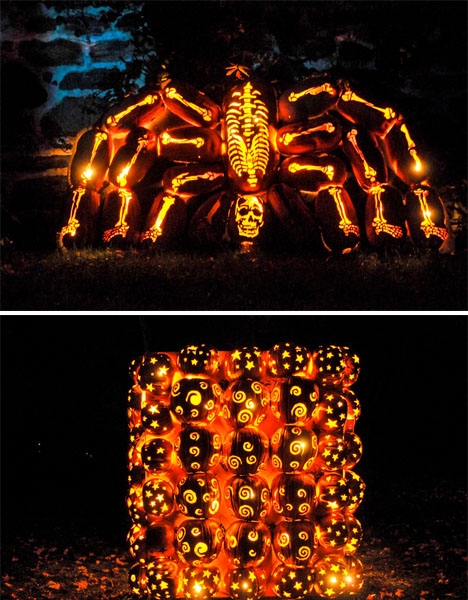
Thanks to @nigelwonguk!
Simple Simon@Alan.

Thanks to @nigelwonguk!
Simple SimonIn a marketing move more shameless than Valentines day - the biggest online retailers had designated 11/11 singles day, and that was the day that single people could shop to forget that they were single.
Simple SimonLooks like a prop from a film - and why did it change colour?!
Simple SimonQuite delightful.

Ucon and 8Bar Bikes got together recently to take the concept of creating a ‘featherlight’ track bike to the next level. Personally, I think this came out great! I really love the paint and the details down to the collaboration caps and straps. The video is a little long, but you get the idea.
Check out more photos of the bike and the process below!













The tiny figures of Slinkachu play out surreal scenarios ranging from dramatic to comedic, all against the backdrop of life-sized props that seem giant by comparison. His latest set of little plays took place on the streets of Paris.


His Little People works hide in plain sight, almost too small to see unless spotted out of the corner of one’s eye. He was invited to France for “ReAct Paris, a conference organised by the European Parliament to tackle the problems of unemployment in Europe, particularly youth unemployment, which in some parts of Europe stand close to a miserable 30%.”


Fitting the theme, most of his installations this time around featured people hard at work, from miniature electricians to tiny scientists, group meetings around graphs and workers arranged on a horizontal I-beam (reenacting a classic New York City Photograph).


Previous Slinkachu series, like the Little People of London, has also been seen in galleries and on the streets of other major cities from New York to Beijing. His subjects often interact with everyday detritus in curious ways, finding their on way to work with whatever they encounter a local scale.







Despacio AKA “The biggest audiophile soundsystem in existence” set for December debut in the capital.
The wood-panelled Ballroom at Hammersmith Town Hall will not have ever heard or seen anything like it. In fact, complete with 1930′s sprung-dancefloor, it is far from the kind of venue you’d associate with a “revolutionary new clubbing experience”. Then again, when has James Murphy ever done things by the book? Having wowed crowds at Manchester’s New Century Hall (a conference room turned disco mecca, itself not your average venue) at this year’s Manchester International Festival, the towering Despacio rig piloted by messrs James Murphy and Soulwax/2ManyDJs brothers David and Stephan Dewaele is set to make its full-blooded London debut on 19th and 20th December.
To describe the Despacio experience as ‘revolutionary’ is to only tell half the story. The concept guiding the seven 11ft speaker stacks that embrace the dancefloor is state-of the art in its simplicity. A night of music, played entirely on vinyl, where the focus is on sound quality, dancing and good times. Of course it also helps if you happen to be powering that party with “the biggest audiophile soundsystem in existence”.
Watch our mini-documentary about Despacio at the Manchester International Festival.
While the spectacular McIntosh amplifiers – 42 of which are nestled in the rig helping Despacio average 100db on the dancefloor – take care of the sound, the success of Despacio lies in its inclusivity. “I don’t feel like it’s small and snobby and elitist” explained Murphy when we spoke to the trio ahead of their second Manchester show, it’s “a place where all different kind of records sound good and it’s a pretty open environment where the music is quite open and the people are quite open and it’s a nice big space”. [Read the full interview here.]
Reclaiming the passion and attention to detail that defined New York’s iconic discos like the Paradise Garage and Studio 54, Despacio (meaning both ‘slow’ and ‘gradually’ in Spanish) harks back to the golden age of the vinyl disc jockey, where considered selection trumped artificial highs and the music was all that mattered. Making a point to differentiate Despacio from 2ManyDJs’ festival gigs which David suggests are defined by “lights, confetti [and] lazers”, Murphy describes the trio’s role as breaking away from the cult of the DJ. “We’re the projectionists – that’s the screen”, he asserts on the press release. In Manchester, the trio had close to 800 records behind the DJs booth, the autonomy to choose playing a crucial role in the organic development of the evening’s entertainment.
Born out of a vision of a utopian dancefloor experience against a Balearic sunset on the island of Ibiza, Despacio has evolved into the world’s most impressive mobile disco; a party bound by a concept that informs its every aspect. Designed by DFA studio engineer John Klett, the rig is pitched to reproduce the music, as it is pressed on vinyl, in its most natural form; loud but not harsh, enveloping but not stifling. As John told us in Manchester: “You put a record on and it would sound awesome. You’d hear the vinyl, cruising underneath of the needle, hear a click and a pop but they’re not going bang, you know it’s just a click and you hear all the dynamics and everything in the groove. It’s pretty groovy.” [You can read the full interview with John Klett on Despacio's technical make-up here.]
Despacio will transform the Ballroom at Hammersmith Town Hall for two nights on 19th and 20th December and tickets for both nights are available to buy HERE.
Simple SimonSimon: Fish / Coriander
Alan: Ouefs
Amel: ...?

Thanks to @alex_france!
Simple SimonMental! Factory Five is a bike shop in Shanghai that I get some stuff from. Run by a dude who's in a hardcore band.


I still have so much leftover film from China, with some of my favorites being the roll of 220 I shot in the bamboo forest on the Mamiya. The guys from Factory 5 rode up to the top of this mountain range on their track bikes and I was on my cross bike, getting shots along the way.
Simple SimonThis!

22% of UK office workers say they are constantly deleting emails from their inbox.
How would you re-imagine business? Find out more at Business Reimagined.
Simple SimonOooh, here is the article that I saw.
Simple SimonDobber drawings are for Americans and other loose moralled westerners. No, in China, they make their comedy cocks much more permanent.
Simple SimonWe're having an ops meeting in Wuxi. This is a sad day for news :(
Simple SimonShouldn't laugh at this, but...
Simple SimonShould make me happy, but it makes me a bit sick.


It’s not everyday that we see professional female athletes shine in cycling. That is, until the UCI Track Cycling World Cup comes around. British Cycling has a ton of exceptional coverage on their site, showcasing the event so don’t miss out. Or, if you prefer to just look at rad photos, check out their Flickr.

A landscape of towering dinosaurs is eerily illuminated with an orange glow at the annual Great Jack O’ Lantern Blaze in New York. A team of professional artists came together to turn more than 5,000 pumpkins into carved masterpieces representing skeletal triceratops, a brontosaurus and even a pterodactyl suspended in a tree.

The pumpkins are stacked and joined together to form cohesive shapes after they’re carved, creating an illusion fiery skeletons from afar. Other designs include a giant spider, snakes and a working grandfather clock.

The pumpkins are situated throughout the riverside grounds of the 18th-century Van Cortland Manor. The event draws tens of thousands of visitors from around the Northeast.

The display will stay up until November 11th and includes sound effects, synchronized lighting and a Museum of Pumpkin Art.





New Zealand artist, illusionist and urbanist Mark Hewson has a good many tricks up his sleeve involving spatial deception, convincing citizens there is less (or more) to their city than can ordinarily be seen.

His first trick in this series: disguising an ordinary street-crossing skyway from a series of key vantage points. But even from alternate angles where the lines do not sync up, the effect is dizzying. Our pattern-seeking brains keep looking for transparency or reflection where there is just a solid painting.

Other illusions in his repertoire involve mirroring or warping unseen elements behind solid surfaces or sheets of material. Again, this toying with voids and our structural expectations induces odd forms of visual vertigo.

In previous projects, like the Lost Space Installation, he has worked with gaps and openings, filling them in with imaginary scenes that range from plausible to impossible. While these may be more obviously fake on the surface, they create a nonetheless potent sense of spatial distortion and disorientation.




Ar Ramadi, Iraq, 24 July 06: “I was supposed to photograph the Iraqi Police receiving medical training, but before I could take my first photo, a mortar exploded about 30 feet behind me. We all ran for cover. Photographing as I was running, an Iraqi “death blossom” opened up and the shooting was coming from all directions. Once the firing finally came to an end we were able to determine that no U.S. forces were injured. What saved us from possibly more casualties was the mortar having landed in a Hesco barrier. We proceeded to go out and search the houses where the shooting was supposedly coming from. No one was found.” —Master Sgt. Jeremy “JT” Lock, U.S. Air Force, Combat Action Diary excerpt

Not many of us know much about being in a war zone, much less working in one. Personally, I’ve been shot at by thugs in Nairobi and photographed in places I probably shouldn’t have been, trying to keep my cool (or at least look like I was), hoping the weeks of repeating camera basics would keep me clicking away in risky conditions when the rest of me wanted to crumble. I’ve lived to tell the tales but have always wondered how combat photographers do what they do.
I guess that’s why I’ve been drawn to veteran Air Force photographer Jeremy Lock’s work.
When I look at Jeremy’s visceral images of Iraq, Afghanistan, and other places, I’m right there with him. His photos are riveting and arresting and make me want to know more. So I asked him.

“Sheer luck” is what got him into photojournalism. He signed up for the Air Force after he was “politely asked … to leave” college. Initially setting his sights on x-ray tech, he was assigned to image processing, as that’s how it goes in the military. Soon enough he had taught himself photography and has never looked back.
Jeremy Lock retired last month after 22 years in the Air Force. During his adrenaline-filled career he was named Military Photojournalist of the Year seven times, awarded the Bronze Star Medal for distinguished service in Iraq, and documented battles, disasters, and everyday life in Afghanistan, Iraq, Japan, Haiti, Mongolia, and many other locations. At every step Lock has been there with camera in hand steadily and skillfully documenting what we might otherwise never see.

When I met with Jeremy, I had many things I wanted to ask him. Here are a few of the things we talked about:
SHERRY BRUKBACHER: As a military photojournalist, how do you have time to think about composition, color, and technique when guns and bombs are going off?
JEREMY LOCK: One great thing about the military is that they train, train, and then train you some more. You are ready by the time you hit the ground, and when things go wrong, your body just reacts the right way.
When I teach photography, I always tell my students to think “out loud” three things every time they put the camera to their eye.
1. Fill the frame
2. Control the background
3. Wait for the moment
If you do this for a while, your mind just takes over. As for calming the nerves, we always talked about what we’d experienced after a bad day. Combat photography is a true adrenaline rush, very dangerous at times. But being able to show what the proud men and women of our great military are doing inspires me to be better and tell their stories. It is an honor and a privilege to document them.

SHERRY: How did you know when to put your camera down and do something else, like use your own gun (if you carried one)?
JEREMY: I carried a 9mm pistol. If we were ever in grave danger, there would be a long gun for me to pick up and use. The rifle gets in the way of performing my job of documenting our brave men and women at war. I feel, even though I am a combatant, my job isn’t to fight unless the team I am with is in a really bad situation. In that case, there will be weapons I can pick up and use. This happened just once, but thankfully I never had to fire back.
…..
In the military we (photographers) were trained to be assets to the team we were working with. We could provide first aid, act as vehicle commander/driver, fight, or act as a soldier in the stack, going into a house if the need arose. However, I saw myself as a photojournalist first, there to document and tell the stories of our Marines, soldiers, sailors, and airmen. If I felt we (the team) were going to be overrun, or there was danger to one of my teammates and they needed my help, it was time to put the camera down. You just know when it is time.

SHERRY: Were there ever occasions when friends or fellow service members were injured in your presence? As a photojournalist how did you handle that? As a person, how did you handle that?
JEREMY: I have seen a lot of death and destruction, good and bad people. I have been lucky enough to experience many different cultures. So, I like to think of my character as enriched. Not only do I get to live my life, I get to live the lives of those I photograph. The way I handle it is to talk about it and remind myself that what I am doing is very important and the world needs to see it. I like to think it hasn’t changed me, but I know it has.
This Q&A has been edited for length.
Simple SimonVery difficult to read stories about this at the moment...and VPN won't connect...
Simple SimonThis says Chengdu, and not Beijing! I was never going to be able to find it!
Simple SimonExpect awesome shots of the nighttime rain in Bergen now, as I try and emulate this...
Secret Sales: Checkout versus Cart prices
For the Canon deals I've found recently, the price in-cart isn't the price you pay.
I've uncovered some secret sales where the price drops below the in-cart price as you complete the checkout process, and then you get a mail-in rebate after that.
The Internet marches on, and these prices and specials change from minute to minute.
Canon 100-400mm Sale
$1,359: Canon 100-400mm L USM IS: Regular price $1,699, price during checkout: $1,359! (it will show as more in cart; you have to checkout to get the secret discount.)
Canon Hot Deals (not live until 3PM NYC time today)
$999: Canon EF 24-70mm f/4L IS: Reg Price $1,499. Price at checkout $1,299, minus $300 mail-in-rebate makes final $999.00, and includes + 4% Adorama rewards and free shipping
$2,248: Canon 6D with 24-105mm f/4L IS: Reg $2499.00, click "buy together and save" to add the printer and paper, and the final price after $400 mail-in rebate drops to $2248.00, and includes 4% rewards and free shipping.
$1,038: Canon 70D. Reg Price $1199.00, click "buy together and save" to add the printer and paper, final price after $400 mail-in rebate is $1038.00, and includes + 4% rewards and free shipping.
NEW: How to Photograph the Milky Way.
You asked, so here you go.
The Milky Way as seen from Bridgeport, California, 8:12 PM, 22 October 2013. Canon 5D Mk III, Canon RS-80N3 remote cord, Canon 16-35mm f/2.8 L II at 16mm, f/2.8 at 32 seconds at ISO 6,400 (LV -8), shot as CR2, processed in Aperture 3 and Photoshop CS6. Bigger.

Emergency shelters are designed to be short-term solutions, and many cannot withstand rain, wind and sun for more than six months. Yet the average stay in refugee camp is over twenty times that duration.

The IKEA Foundation, in cooperation with the United Nations High Commissioner for Refugees, has developed a longer-term solution to this problem, turning their experience with flat-pack furniture and language-free instruction manuals toward disaster relief efforts in and around war-torn places like Syria (they are already testing in Lebanon and Iraq). Sticklers for detail should scroll carefully below for a step-by-step deconstruction of what goes into this remarkable dwelling.

The problem, in part, is building the most universal unit possible in a world where emergencies happen globally, spanning regions both hot and cold and with vastly different cultural norms. Their solution is much like an ordinary IKEA product: flexible, adaptable, modular and packed into cardboard boxes of components. Naturally, they require no tools that are not included.

While the structures themselves are still only expected to last a few years, they are made to be modified, enhanced and expanded in various ways. For instance, earthen walls and corrugated metal roofs can be pushed up against, fastened to and ultimately help reinforce the core buildings, or even eventually replace the need for underlying framework entirely, rendering it redundant.

The shelters are constructed primarily from polymer panels that clip into a wire frame. On top sits an aluminum-mesh roofing sheet that is designed to reflect sunlight by day and retain heat by night. Solar energy charges a USB outlet for electrical needs. The target price range for mass production is under $1000, making it affordable in bulk to international organizations. Images and diagram via The Telegraph, IKEA Foundation and Graphic News.



